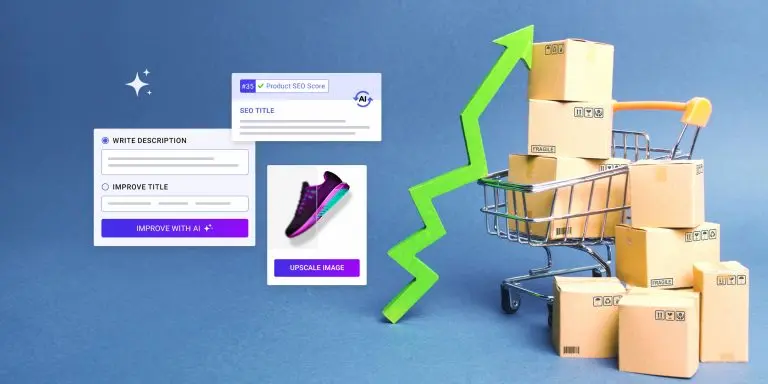Even though dropshipping is a popular business model, it’s also filled with potential pitfalls that can derail your success if you’re not careful. Of course, we’ve been writing about this since the start (read here and here).
But the good news is that these disasters can be managed and even transformed into opportunities for growth. So today we decided to write another article explaining some common dropshipping mistakes and how you can bounce back from them.
Table of Contents
The common dropshipping mistakes
Mistake #1: Choosing the wrong supplier
Selecting a reliable supplier is crucial. Imagine this: you’ve launched your store, orders start rolling in, but then you realize your supplier is out of stock or shipping low-quality products. This can lead to unhappy customers, negative reviews, and a damaged reputation.
How can you recover?
- Research and vet suppliers: Before partnering with a supplier, do thorough research. Look for reviews, ask for references and order samples. It’s like dating – you need to know who you’re getting involved with.
- Have a backup plan: Always have a backup supplier. This way, if your primary supplier fails, you have an alternative ready to step in.
- Choose a dropshipping platform: You can also go for a dropshipping platform, like AppScenic, one where all suppliers are vetted for following high-quality standards. This way you’re not only sure about the reliability of your suppliers but you can also have a backup.
- Transparent communication: If issues happen, communicate transparently with your customers. Let them know about delays and offer solutions, such as discounts or refunds. Honesty goes a long way in maintaining trust.
Mistake #2: Poor product quality
Selling poor-quality products can be a nightmare. Customers expect value for their money, and when they receive items that don’t meet expectations, they won’t be happy and won’t come back for more.. This mistake can lead to returns, chargebacks, and a damaged brand image.
How to Recover
- Quality checks: Implement a strict quality control process. Regularly check the products yourself or hire a third party to do so.
- Clear product descriptions: Ensure your product descriptions are accurate and detailed. Misleading descriptions can set unrealistic expectations.
- Handle complaints professionally: Address complaints swiftly and professionally. Offer refunds, replacements, or other forms of compensation to dissatisfied customers.

Mistake #3: Ignoring customer service
Good customer service is the backbone of any successful business. Ignoring customer inquiries or complaints can lead to frustration and negative feedback. But it doesn’t stop there. Poor customer service can have far-reaching consequences beyond just unhappy customers.
How bad customer service impacts your business
- Payment Gateway Account: Poor customer service often leads to a high number of chargebacks and disputes. If your customers feel neglected or unheard, they’re more likely to reverse their charges. Too many chargebacks can result in your payment processor flagging your account, and eventually, it can lead to your account being blocked. This can cripple your business operations, as you’ll struggle to process payments smoothly.
- Ad Account: Negative customer experiences can also impact your advertising efforts. If customers start reporting your ads on social media platforms like Facebook due to poor service, you risk having your ad account suspended or permanently banned. Losing your ad account means losing a vital channel for driving traffic and sales.
How to recover
- Be responsive: Aim to respond to customer inquiries within 24 hours. Even if you don’t have a solution yet, acknowledging their concern makes a big difference.
- Train your team: Ensure your customer service team is well-trained and equipped to handle various situations. Empathy and professionalism are key.
- Use automation tools: Leverage automation tools to manage and streamline customer service. Tools like Zendesk or Freshdesk can help you stay organized and responsive.
Mistake #4: Inadequate marketing strategies
You’ve got great products, but no one knows about them. Without effective marketing, your store will struggle to attract traffic and make sales.
How to recover
- Use social media: Social media is a powerful tool for marketing. Use platforms like Instagram, Facebook, and Pinterest to showcase your products and engage with potential customers.
- Invest in SEO: Search engine optimization (SEO) can help improve your website’s visibility. Use relevant keywords, optimize your site’s speed, and create valuable content to attract organic traffic.
- Google Ads for High-Ticket Items: Google Ads is generally recommended for high-ticket items. The platform works well for products with higher profit margins because it targets users who are actively searching for specific items, often with high buy intent. Before you start advertising on Google, check the search volume for keywords related to your product. This helps you understand if there’s a demand and if people are consistently searching for that product. Remember, Google is a place with the highest buy intent, so ensure people are interested in your niche before spending on ads.
- Social Media Ads for Low-Ticket Items: Platforms like Facebook, Instagram, and TikTok are better suited for low-ticket items. These platforms allow for more engaging and visually appealing ads that can capture the attention of users who may not be actively searching for your product but can be persuaded to make impulse purchases.
- Start a blog: For better ranking and visibility, make sure you start a blog. Find out what your potential customers are searching for, and what are their problems, then try answering with an informative article.
Mistake #5: Overlooking shipping logistics
Shipping is a critical aspect of dropshipping. Delayed shipments, lost packages, or high shipping costs can frustrate customers and harm your business.
How to recover
- Choose reliable shipping partners: Partner with reliable shipping companies to ensure timely deliveries. Consider offering tracking options to keep customers informed.
- Set realistic expectations: Clearly communicate shipping times and costs to your customers. Transparency helps manage expectations.
- Efficient handling of issues: When shipping problems occur, address them promptly. Offer solutions such as expedited shipping or refunds to mitigate dissatisfaction.
- Use a dropshipping automation platform: AppScenic can be your gateway to automating all these critical aspects of your business, as we sync the entire ordering process, from products and prices to stock and shipping tracking.
Mistake #6: Losing your ad account or payment gateway account
One of the most devastating setbacks in dropshipping is losing your ad account or payment gateway account. This can cripple your ability to reach customers and process transactions, leading to significant business disruption.
How to Recover
- Understand the risks: First, understand why accounts get suspended. Common reasons include policy violations, excessive chargebacks, and suspicious activity. Ensure you’re familiar with the terms of service for both ad platforms and payment processors.
- Diversify your advertising channels: Don’t rely on a single ad platform. Spread your marketing efforts across multiple channels such as Facebook, Instagram, Google Ads, TikTok, and Pinterest. This way, if one account gets suspended, you still have other active campaigns driving traffic to your store.
- Backup payment gateways: Set up multiple payment gateways like Stripe, PayPal, Square, and alternative options like Payoneer or Skrill. If one payment processor suspends your account, you can quickly switch to another to maintain cash flow.
- Create backup accounts: For advertising, consider creating backup accounts with different payment methods and contact details. This ensures you can quickly pivot to a new account if your primary one is suspended. Be cautious and follow platform rules to avoid getting all your accounts suspended.
- Monitor account health: Regularly monitor the health of your ad and payment gateway accounts. Stay within acceptable chargeback ratios, adhere to advertising policies, and maintain transparent communication with your payment processors.
- Have a crisis plan: Develop a crisis management plan that outlines steps to take if an account is suspended. This plan should include contacting support, gathering necessary documentation, and implementing backup methods.
- Engage with customer service: If your account is suspended, immediately contact the platform’s customer service. Provide all required information and be patient but persistent. Often, suspensions can be appealed and resolved if you can demonstrate compliance.
How to turn disasters into opportunities
Listen to your customers’ feedback
Customer feedback, even negative, is invaluable. It provides insights into what’s working and what’s not. Embrace this feedback and use it to improve your business. Think of it as a roadmap guiding you toward a better customer experience.
Keep on learning and adapting
The ecommerce landscape is constantly evolving. Stay updated with the latest trends, tools, and best practices. Continuous learning and adaptation can help you stay ahead of the competition and turn potential disasters into growth opportunities.
Build a resilient brand
Building a resilient brand means preparing for setbacks and having strategies in place to recover from them. This includes having a crisis management plan, maintaining strong supplier relationships, and investing in customer service. A strong brand can endure challenges and come out even stronger.
Leverage technology
Technology can be your best friend in managing and recovering from dropshipping disasters. Use inventory management tools, automation software, AI tools and analytics platforms to streamline operations and make informed decisions. Technology can help you anticipate problems and respond to them more effectively.
Engage with your community
Engage with your community. Whether it’s through social media, forums, or customer feedback channels, staying connected with your audience can help you understand their needs and preferences. Building a strong community around your brand can turn customers into advocates, even when things go wrong.

Case study: A dropshipping disaster turned into a success
Let’s now look at a hypothetical case study to illustrate how these strategies can work in real life.
The problem
“EcoBikesStore” is a dropshipping store specializing in e-bikes. They partnered with a new supplier offering e-bike accessories. However, the supplier delivered low-quality products, resulting in a flood of complaints and negative reviews.
The recovery plan
- Immediate Action: EcoBikesStore stopped selling the faulty chargers and removed them from their listings.
- Transparent Communication: They sent apology emails to affected customers, explaining the issue and offering full refunds or replacements.
- Supplier Change: They found a new, more reliable supplier and conducted thorough quality checks.
- Customer Service Focus: They invested in training their customer service team to handle complaints effectively and empathetically.
- Feedback Utilization: EcoBikesStore used customer feedback to improve their product descriptions and set more realistic expectations.
The outcome
While the incident initially hurt their reputation, EcoBikesStore’s swift and transparent response helped rebuild customer trust. Their commitment to quality and customer service turned dissatisfied customers into loyal advocates. In the long run, they emerged stronger and more resilient.
Conclusion
Yes, dropshipping disasters are inevitable, just like in any business. But they don’t have to be the end of your business. By understanding common mistakes and having a robust recovery plan, you can navigate these challenges and turn them into opportunities.
So, listen to your customers’ feedback, invest in customer service, leverage technology, and keep on learning and adapting. With the right approach, you can recover from dropshipping disasters and build a successful dropshipping business.











